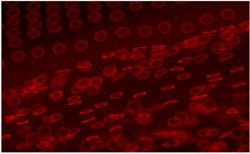Although it may not be tasty to vampires, synthetic blood holds potential for treatments such as oxygen transport, drug delivery. The technology got a boost recently and researchers say their work could even treat certain cancers.
January 10, 2011

Although it may not be tasty to vampires, synthetic blood holds potential for treatments such as oxygen transport, drug delivery. The technology got a boost recently and researchers say their work could even treat certain cancers.
|
Extremely flexible hydrogel particles that resemble red blood cells in size and shape. In testing, these flexible particles remained in circulation up to 30 times longer than stiffer ones. Image courtesy of Timothy J. Merkel and Joseph M. DeSimone, University of North Carolina at Chapel Hill. |
A discovery from the University of North Carolina (UNC) at Chapel Hill involves the use of particle replication in nonwetting templates (PRINT) to produce soft hydrogel particles. These particles mimic the size, shape, and flexibility of blood cells.
The university has tested these particles to transport oxygen or therapeutic drugs. This is not the first time synthetic blood particles have been tested, but usually, the outer material is too inflexible and cannot stay in a patient’s system long in enough to achieve the desired effects.
The researchers at Chapel Hill think their design may be more efficient because of the hyrdogel’s flexibility. Flexibility is required because it mimic’s natural red blood cells, which deform to pass through pores and blood vessels.
“Creating particles for extended circulation in the blood stream has been a significant challenge in the development of drug-delivery systems,” says Joseph DeSimone, Ph.D., the study’s colead investigator. DeSimone is Chancellor’s eminent professor of chemistry in UNC’s college of arts and sciences.
|
Synthetic red blood cell mimics, shown releasing from an adhesive film into a drop of solvent. The particles were manufactured using PRINT technology. Image courtesy Timothy J. Merkel and Joseph M. DeSimone, University of North Carolina at Chapel Hill. |
Researchers designed the hydrogel material for the study to make particles of varying stiffness. Then, using PRINT technology—a technique invented in DeSimone’s lab to produce nanoparticles with control over size, shape and chemistry—they created molds, which were filled with the hydrogel solution and processed to produce thousands of red blood cell-like discs, each measuring 6 μm in diameter.
The team tested the particles to determine their ability to circulate in the body without being filtered out by various organs. When tested in mice, the more flexible particles lasted 30 times longer than stiffer ones. The least flexible particles disappeared from circulation with a half-life of 2.88 hours, compared with 93.29 hours for the most flexible ones. For further comparison, natural red blood cells typically circulate for 120 days.
Stiffness also influenced where particles eventually ended up. The more-rigid particles tended to settle in the lungs, but the more flexible particles were removed by the spleen, the organ that typically removes old real red blood cells.
Beyond moving closer to producing fully synthetic blood, the findings could affect approaches to treating cancer. Cancer cells are softer than healthy cells and they lodge in different places in the body, leading to the disease’s spread. Particles loaded with cancer-fighting medicines that can remain in circulation longer may open the door to targeted treatment approaches.
DeSimone says that the team has much additional work to do before moving to human studies. “Although we will have to consider particle deformability along with other parameters when we study the behavior of particles in the human body, we believe this study represents a real game changer for the future of nanomedicine,” DeSimone says.
The research was funded through the American Recovery and Reinvestment Act stimulus grant provided by the National Heart, Lung and Blood Institute, part of the National Institutes of Health (NIH). The National Science Foundation, the Carolina Center for Cancer Nanotechnology Excellence, the NIH Pioneer Award Program, and Liquidia Technologies, a privately held nanotechnology company developing vaccines and therapeutics based on the PRINT particle technology, also provided support. DeSimone cofounded Liquidia, which holds an exclusive license to the PRINT technology from UNC.
About the Author(s)
You May Also Like
.jpg?width=700&auto=webp&quality=80&disable=upscale)



